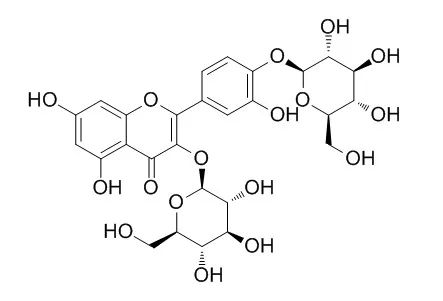| In vitro: |
| Food Research International, 2015, 67(jan.):349-355. | | The microbial degradation of onion flavonol glucosides and their roasting products by the human gut bacteria Eubacterium ramulus and Flavonifractor plautii.[Reference: WebLink] | Flavonoids are important constituents of the human diet. One source for flavonols, a major subclass of the flavonoids, is onion. It contains high amounts of quercetin glycosides, primarily quercetin 3,4′-di-O-glucoside (QDG) and quercetin-4′-O-monoglucoside (Q-4′-MG). Due to their high reactivity flavonols are susceptible to thermal degradation as used in food processing. Especially boiling and roasting influence the flavonoid content of food products. Quercetin and several of its glycosides may serve as substrates for human gut bacteria. For example, Eubacterium ramulus and Flavonifractor plautii are capable of cleaving the aglycone quercetin to form 3,4-dihydroxyphenylacetic acid (DHPAA) and phloroglucinol which to some extent can be degraded further. The aim of this study was to find out whether E. ramulus and F. plautii are also capable of degrading Q-4′-MG and QDG by and to investigate the influence of a thermal treatment (roasting) of the onion glucosides on the subsequent microbial degradation.
METHODS AND RESULTS:
In this study, E. ramulus was capable of degrading Q-4′-MG and QDG, while F. plautii was not. Roasting of QDG at 180 °C for 5 min led to the formation of quercetin with Q-4′-MG and quercetin-3-O-monoglucoside (Q-3-MG) as intermediates. Roasting accelerated the microbial degradation of Q-4′-MG and QDG. In the case of F. plautii, microbial degradation was induced by quercetin which was formed during roasting and is a preferred substrate of this organism. | | Food Chemistry, 2017, 235(nov.15):119-126. | | Utilization of quercetin and quercetin glycosides from onion (Allium cepa L.) solid waste as an antioxidant, urease and xanthine oxidase inhibitors.[Reference: WebLink] | This study aimed to determine the flavonol glycosides from onion solid waste (OSW) using HPLC analysis, with antioxidant and enzyme inhibitory activities.
METHODS AND RESULTS:
We found considerable amount of quercetin-4'-O-monoglucoside (QMG: 254.85), quercetin-3,4'-O-diglucoside (Quercetin 3,4'-diglucoside, QDG: 162.34), quercetin (Q: 60.44), and isorhamnetin-3-glucoside (IMG: 23.92) (mg/100g) dry weight (DW) of OSW. For OSW, the methanol and ethanol showed the strongest antioxidant activities, followed by ethyl acetate, chloroform, and n-hexane extracts. Among the flavonols, Q and QDG possessed higher antioxidant activities. OSW and flavonol glycosides displayed significant enzyme inhibitory activity, with IC50 values ranging from 12.5±0.11 to 32.5±0.28 for OSW, 8.2±0.07 to 16.8±0.02 for flavonol glycosides, and 4.2±0.05μg/mL for thiourea (positive control) towards urease; while 15.2±0.8 to 35.8±0.2 (μg/mL) for OSW, 10.5±0.06 to 20.8±0.05 (μg/mL) for flavonol glycosides, and 6.5±0.05μg/mL for allopurinol (positive control) towards xanthine oxidase, respectively.
CONCLUSIONS:
The OSW and flavonol glycosides may thus be considered as potential antioxidant and antigout agents. | | Food Chemistry, 2011, 124(3):p.1024-1028. | | Anti-melanogenesis properties of quercetin- and its derivative-rich extract from Allium cepa.[Reference: WebLink] | In an effort to find a new whitening agent, we have found that the methanol extract of the dried skin of Allium cepa showed inhibition of melanin formation.
METHODS AND RESULTS:
Bioassay-guided fractionation led to the isolation of quercetin (1) and quercetin 4'-O-β-glucoside (3) from A. cepa as the inhibitors of melanin formation in B16 melanoma cells with IC₅₀ values of 26.5 and 131μM, respectively. In addition, we evaluated the effect of some quercetin derivatives, such as isoquercitrin (2),
quercetin 3,4'-O-diglucoside (Quercetin 3,4'-diglucoside, 4), rutin (5) and hyperin (6) on B16 melanoma cells. These quercetin derivatives did not show any inhibition of melanin formation. Furthermore, the ORAC values of compounds 1-6 were 7.64, 8.65, 4.82, 4.32, 8.17 and 9.34μmol trolox equivalents/μmol, respectively.
CONCLUSIONS:
Dried skin of red onion showed inhibitory activity against melanin formation in B16 melanoma cells, as well as antioxidant properties. |
|






 Cell. 2018 Jan 11;172(1-2):249-261.e12. doi: 10.1016/j.cell.2017.12.019.IF=36.216(2019)
Cell. 2018 Jan 11;172(1-2):249-261.e12. doi: 10.1016/j.cell.2017.12.019.IF=36.216(2019) Cell Metab. 2020 Mar 3;31(3):534-548.e5. doi: 10.1016/j.cmet.2020.01.002.IF=22.415(2019)
Cell Metab. 2020 Mar 3;31(3):534-548.e5. doi: 10.1016/j.cmet.2020.01.002.IF=22.415(2019) Mol Cell. 2017 Nov 16;68(4):673-685.e6. doi: 10.1016/j.molcel.2017.10.022.IF=14.548(2019)
Mol Cell. 2017 Nov 16;68(4):673-685.e6. doi: 10.1016/j.molcel.2017.10.022.IF=14.548(2019)